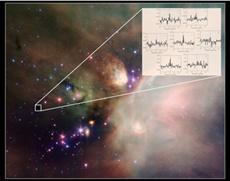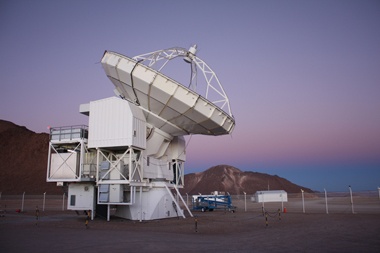Astronomers observe a rare molecule within a star-forming cloud
31 Dec 2010
The air in space may be thin, but space is not completely empty: cold clouds of dust and gas, which consist mainly of hydrogen, wallow between the stars. They contain rare molecules such as H2D+ and D2H+, formed from the hydrogen atom H and its heavier isotope deuterium D.
 |
| The Rho Ophiuchi dark cloud is a star-forming region at a distance of approx. 400 light years. Overlaid onto an infrared image, the insert shows spectra of the rare molecule D2H+, detected with the APEX telescope in Chile. Image: Bérengère Parise (compilation) / background: Spitzer Space Telescope. NASA/JPL-Caltech/L. Allen (CfA) & D. Padgett (SSC-Cattech). Insert: D2H+ Spectra (Champ+/APEX) |
Deuterium, whose nucleus consists of one proton and one neutron, is about 100,000 times rarer in space than hydrogen, which has only one proton in the nucleus.
These molecules are therefore very difficult to detect. A team at the Bonn-based Max Planck Institute for Radio Astronomy headed by Bérengère Parise has succeeded in performing a wonder: the researchers used the APEX telescope to map the spatial distribution of the D2H+ species in the Rho Ophiuchi dark cloud, a star-forming region. (Astronomy & Astrophysics, December 16, 2010)
Stars form inside dense and extremely cold clouds of dust and gas. This is why most of the gaseous molecules freeze on the surface of solid dust grains, similar to the way water vapour condenses on the sides of fridges.
This causes most molecules to disappear from the gas, making it very difficult to observe molecular emission from these objects. At the same time, very special chemical processes occur between the molecules remaining in the gaseous phase: at temperatures of about 10 Kelvin (corresponding to approx. minus 260 degrees Celsius) many light molecules containing deuterium are formed, in particular the light tri-atomic species, such as H2D+ and D2H+.
These molecules have already been the target of many observational searches in the past decade. "The line emission of these molecules helps us to understand the extreme physical conditions that prevail in the clouds of stars being formed," says Bérengère Parise, who leads the Emmy Noether research group at the Max Planck Institute for Radio Astronomy in Bonn. "And we learn a lot about the processes leading to the formation of stars and their planetary systems in the process."
The molecules emit extremely weak radiation with a high frequency and wavelengths shorter than one millimetre, however. This so-called "submillimetre" range can only be observed from earth under ideal weather conditions. Powerful telescopes must therefore be located at the best observing sites. In addition, the observation of D2H+ is even more difficult than that of H2D+ , as it radiates at an even higher frequency.
This explains why most observational searches for this molecule have thus far been unsuccessful - to date, there has been only one observation, and this had an uncertain frequency calibration.
For their most recent measurements the researchers used the APEX radio telescope, which is sited at an altitude of 5,100 metres on the Chajnantor plain in the Atacama Desert in Chile. And they used a special receiver. "Our CHAMP+ is a very powerful instrument," says Rolf Güsten, head of the submillimetre technology group at the Max Planck Institute for Radio Astronomy. "With its help we can record astronomical signals at seven different positions in the sky simultaneously. And what is even better, at two different frequencies as well."
The researchers were thus able, for the first time, to observe the emission of D2H+ in the direction of a cold core within the Rho Ophiuchi dark cloud at seven positions simultaneously. This observation would have been nearly impossible with an instrument with a single detection pixel, owing to the long integration time required to detect the weak signal at every position.
In addition to the conclusive detection of D2H+ the group succeeded in making a surprising discovery: the molecule was not only detected in the coldest region in the centre of the core, but also in the immediate neighbourhood. It appears that the freezing of molecules on dust grains is an extremely effective process.
 |
| The APEX telescope at 5,100 m above sea level in Chile. Image: Bérengère Parise |
The researchers thus discovered an important piece of information for understanding the chemistry that takes place in the cosmic birthplaces of stars. "The additional information on the spatial distribution of D2H+ provided by the CHAMP+ observations opens up the possibility of investigating the chemical and physical processes taking place during the early phases of star formation in detail," says Parise. Her team wants to soon continue their measurements.




















.jpg)









